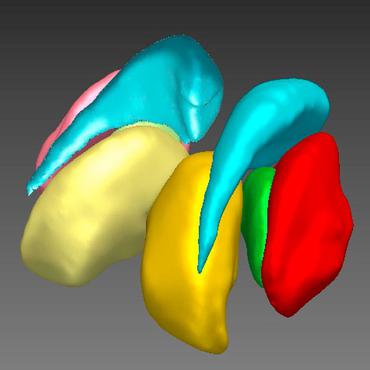Brain Segmentation
60 papers with code • 1 benchmarks • 4 datasets
Libraries
Use these libraries to find Brain Segmentation models and implementationsMost implemented papers
Concurrent Spatial and Channel Squeeze & Excitation in Fully Convolutional Networks
Fully convolutional neural networks (F-CNNs) have set the state-of-the-art in image segmentation for a plethora of applications.
QuickNAT: A Fully Convolutional Network for Quick and Accurate Segmentation of Neuroanatomy
We introduce QuickNAT, a fully convolutional, densely connected neural network that segments a \revision{MRI brain scan} in 20 seconds.
MRI Super-Resolution using Multi-Channel Total Variation
This paper presents a generative model for super-resolution in routine clinical magnetic resonance images (MRI), of arbitrary orientation and contrast.
Association of genomic subtypes of lower-grade gliomas with shape features automatically extracted by a deep learning algorithm
Based on automatic deep learning segmentations, we extracted three features which quantify two-dimensional and three-dimensional characteristics of the tumors.
VoxResNet: Deep Voxelwise Residual Networks for Volumetric Brain Segmentation
Recently deep residual learning with residual units for training very deep neural networks advanced the state-of-the-art performance on 2D image recognition tasks, e. g., object detection and segmentation.
3D fully convolutional networks for subcortical segmentation in MRI: A large-scale study
To the best of our knowledge, our work is the first to study subcortical structure segmentation on such large-scale and heterogeneous data.
HyperDense-Net: A hyper-densely connected CNN for multi-modal image segmentation
Therefore, the proposed network has total freedom to learn more complex combinations between the modalities, within and in-between all the levels of abstraction, which increases significantly the learning representation.
A Learning Strategy for Contrast-agnostic MRI Segmentation
These samples are produced using the generative model of the classical Bayesian segmentation framework, with randomly sampled parameters for appearance, deformation, noise, and bias field.
CrossMoDA 2021 challenge: Benchmark of Cross-Modality Domain Adaptation techniques for Vestibular Schwannoma and Cochlea Segmentation
The aim was to automatically perform unilateral VS and bilateral cochlea segmentation on hrT2 as provided in the testing set (N=137).
Deep Neural Networks for Anatomical Brain Segmentation
To our knowledge, our technique is the first to tackle the anatomical segmentation of the whole brain using deep neural networks.


 CrossMoDA
CrossMoDA
 BRATS 2021
BRATS 2021
 Tc1 Mouse cerebellum atlas
Tc1 Mouse cerebellum atlas
 Multi-template MRI mouse brain atlas
Multi-template MRI mouse brain atlas
